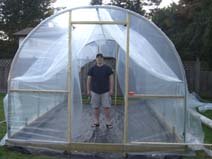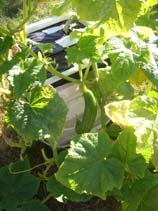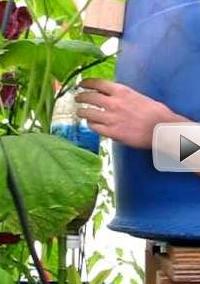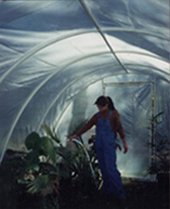|
Greenhouse Poly, Poly film:Greenhouse poly film with ultraviolet (UV) protection is the least expensive of the glazing materials. It is the glazing that we use for our Greenhouses. Hoop housesare a cheap and easy way to build a greenhouse. The polyethylene, an unbreakable, long lasting and easy to replace cover, provides the high light transmission for the plants with increased safety (won’t shatter or break) and insulation value. Poly Greenhouses keep the insects and pests away, let’s the sun’s rays in, and traps the heat. Polyethylene film is available with life expectancy of one to four years depending whether it has been UV protected. Poly is also very light in weight, and is easy and safe to work with for the Do-it-yourself (DIY) gardener. Most Popular of the Greenhouse Covering Material:According to the National Greenhouse Manufacturers Association (NGMA) poly film is still the first choice for covering greenhouses, mostly because of its low cost, and ease of use – anyone can cover their own greenhouse with this material. Air-inflated double-polyethylene film greenhouses (see Insulation below), can represent up to 80% of new greenhouse construction in the United States.
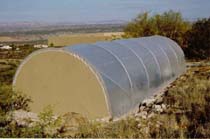
I live in Vancouver, British Columbia, Canada – I don’t have stats for here, but if I take a drive greenhouses with poly coverings are definitely the ones that I primarily seen the most, and there are a lot of greenhouses here. In terms of heat conservation, a double layer of poly will reduce heat loss during the winter by 30–40% when compared to glass, therefore lower heating expenses. Poly Film Quality:Manufacturers are improving the Poly film all of the time. Before UV protection was offered in the poly, it didn’t last very long. With the new greenhouse poly offered today, grower’s can get up to four years. More if it is maintained, and shade clothe is used during the peak hot sunny times of summer, for added protection from the UV rays. As I mentioned, this is my preferred glazing material for ease of installation, versatility and low cost. It is easily replaced as needed and is the least expensive glazing choice. Attaching it to the Greenhouse Frame:There are a number of ways that the poly can be attached to a greenhouse frame. We chose to use poly clip or poly channel to attach the poly covering to our galvanized hoop house. If the ends are rolled they it can also be stapled, or run a strip of 1”x1” wood strip to sandwich the poly to the structure. The benefit of using the poly lock is that it makes it easy to change the poly when it comes time. Take it off, and put the new stuff back on. Quick, easy, and painless. Poly can cover a number of greenhouse frames: Wood Frame construction or Hoop Tunnels made out of PVC or Galvanized Hoop Tunnels. This glazing is pretty versatile. 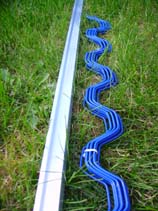
Poly can cover a number of greenhouse frames: Wood Frame construction or Hoop Tunnels made out of PVC or Galvanized Hoop Tunnels. This glazing is pretty versatile. Insulation - Heat Retention:Air-inflated greenhouse poly surfaces experience roughly 60 percent less of the heat loss compared to a single layer of glass or plastic glazing. I personally have never tried using the bubble wrap, but I have heard of people using bubble wrap to help insulate their greenhouses during the winter season. Makes sense, the bubbles are filled with air, and would create a great insulating barrier. Could be used in any greenhouse. Greenhouse Poly, Pros and Cons:
|
Please Help Us Get Social:
Valued Links and Featured Sites:
Greenhouse Plans
Free Greenhouse Gardening Construction Plans
"Ole Dirt Farmer"

Self Watering Container Plans
Don't want to make your own. There is also information about Earthboxes too.
These are great, either or.
Free Self Watering Container Plans
Jonathan White: Food 4 Wealth
It is a great fit. Be sure to take a look. Jonathan is a passionate guy. See below for our full review.
Aquaponic Plans
Links on this page will take you to Travis's free e-book.
A Malispina college student shares a video of her completed Barrelponic project. Complete with Tilapia.
Free Aquaponics (Fish and Vegetables) Plans






